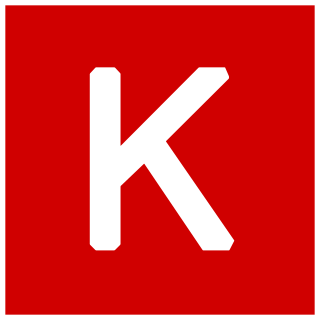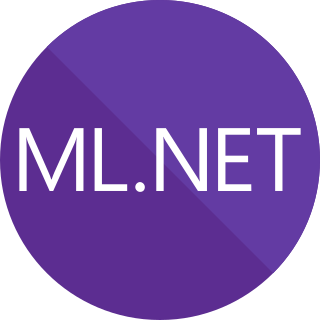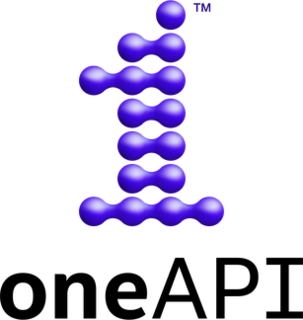
A graphics processing unit (GPU) is a specialized electronic circuit designed to rapidly manipulate and alter memory to accelerate the creation of images in a frame buffer intended for output to a display device. GPUs are used in embedded systems, mobile phones, personal computers, workstations, and game consoles.

LLVM is a set of compiler and toolchain technologies, which can be used to develop a front end for any programming language and a back end for any instruction set architecture. LLVM is designed around a language-independent intermediate representation (IR) that serves as a portable, high-level assembly language that can be optimized with a variety of transformations over multiple passes.
General-purpose computing on graphics processing units is the use of a graphics processing unit (GPU), which typically handles computation only for computer graphics, to perform computation in applications traditionally handled by the central processing unit (CPU). The use of multiple video cards in one computer, or large numbers of graphics chips, further parallelizes the already parallel nature of graphics processing.

OpenCV is a library of programming functions mainly aimed at real-time computer vision. Originally developed by Intel, it was later supported by Willow Garage then Itseez. The library is cross-platform and free for use under the open-source Apache 2 License. Starting with 2011, OpenCV features GPU acceleration for real-time operations.

CUDA is a parallel computing platform and application programming interface (API) that allows software to use certain types of graphics processing unit (GPU) for general purpose processing – an approach called general-purpose computing on GPUs (GPGPU). CUDA is a software layer that gives direct access to the GPU's virtual instruction set and parallel computational elements, for the execution of compute kernels.

OpenCL is a framework for writing programs that execute across heterogeneous platforms consisting of central processing units (CPUs), graphics processing units (GPUs), digital signal processors (DSPs), field-programmable gate arrays (FPGAs) and other processors or hardware accelerators. OpenCL specifies programming languages for programming these devices and application programming interfaces (APIs) to control the platform and execute programs on the compute devices. OpenCL provides a standard interface for parallel computing using task- and data-based parallelism.
Apache Mahout is a project of the Apache Software Foundation to produce free implementations of distributed or otherwise scalable machine learning algorithms focused primarily on linear algebra. In the past, many of the implementations use the Apache Hadoop platform, however today it is primarily focused on Apache Spark. Mahout also provides Java/Scala libraries for common math operations and primitive Java collections. Mahout is a work in progress; a number of algorithms have been implemented.
Numba is an open-source JIT compiler that translates a subset of Python and NumPy into fast machine code using LLVM, via the llvmlite Python package. It offers a range of options for parallelising Python code for CPUs and GPUs, often with only minor code changes.

Eclipse Deeplearning4j is a programming library written in Java for the Java virtual machine (JVM). It is a framework with wide support for deep learning algorithms. Deeplearning4j includes implementations of the restricted Boltzmann machine, deep belief net, deep autoencoder, stacked denoising autoencoder and recursive neural tensor network, word2vec, doc2vec, and GloVe. These algorithms all include distributed parallel versions that integrate with Apache Hadoop and Spark.

TensorFlow is a free and open-source software library for machine learning and artificial intelligence. It can be used across a range of tasks but has a particular focus on training and inference of deep neural networks.
The following table compares notable software frameworks, libraries and computer programs for deep learning.
Apache SystemDS is a flexible machine learning system that automatically scales to Spark and Hadoop clusters. SystemDS's distinguishing characteristics are:
- Algorithm customizability via R-like and Python-like languages.
- Multiple execution modes, including Standalone, Spark Batch, Spark MLContext, Hadoop Batch, and JMLC.
- Automatic optimization based on data and cluster characteristics to ensure both efficiency and scalability.
An AI accelerator is a class of specialized hardware accelerator or computer system designed to accelerate artificial intelligence and machine learning applications, including artificial neural networks and machine vision. Typical applications include algorithms for robotics, internet of things, and other data-intensive or sensor-driven tasks. They are often manycore designs and generally focus on low-precision arithmetic, novel dataflow architectures or in-memory computing capability. As of 2018, a typical AI integrated circuit chip contains billions of MOSFET transistors. A number of vendor-specific terms exist for devices in this category, and it is an emerging technology without a dominant design.

Keras is an open-source software library that provides a Python interface for artificial neural networks. Keras acts as an interface for the TensorFlow library.

SYCL is a higher-level programming model to improve programming productivity on various hardware accelerators. It is a single-source domain-specific embedded language (DSEL) based on pure C++17. It is a standard developed by Khronos Group, announced in March 2014.
PyTorch is an open source machine learning framework based on the Torch library, used for applications such as computer vision and natural language processing, primarily developed by Facebook's AI Research lab (FAIR). It is free and open-source software released under the Modified BSD license. Although the Python interface is more polished and the primary focus of development, PyTorch also has a C++ interface.
ROCm is an Advanced Micro Devices (AMD) software stack for graphics processing unit (GPU) programming. ROCm spans several domains: general-purpose computing on graphics processing units (GPGPU), high performance computing (HPC), heterogeneous computing. It offers several programming models: HIP, OpenMP/Message Passing Interface (MPI), OpenCL.

ML.NET is a free software machine learning library for the C# and F# programming languages. It also supports Python models when used together with NimbusML. The preview release of ML.NET included transforms for feature engineering like n-gram creation, and learners to handle binary classification, multi-class classification, and regression tasks. Additional ML tasks like anomaly detection and recommendation systems have since been added, and other approaches like deep learning will be included in future versions.

Flux is an open-source machine-learning software library and ecosystem written in Julia. Its current stable release is v0.12.8. It has a layer-stacking-based interface for simpler models, and has a strong support on interoperability with other Julia packages instead of a monolithic design. For example, GPU support is implemented transparently by CuArrays.jl This is in contrast to some other machine learning frameworks which are implemented in other languages with Julia bindings, such as TensorFlow.jl, and thus are more limited by the functionality present in the underlying implementation, which is often in C or C++. Flux joined NumFOCUS as an affiliated project in December of 2021.

oneAPI is an open standard for a unified application programming interface intended to be used across different compute accelerator (coprocessor) architectures, including GPUs, AI accelerators and field-programmable gate arrays. It is intended to eliminate the need for developers to maintain separate code bases, multiple programming languages, and different tools and workflows for each architecture.











